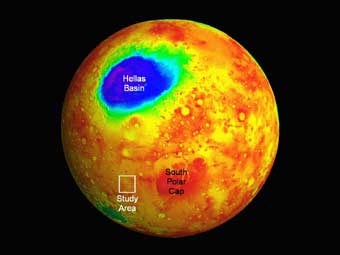Hunt for life on Mars dealt another blow

Map Showing location of study area
An Australian geologist has identified what could be the first ever active flow of fluids through gullies on Mars.
University of Melbourne geologist, Dr Nick Hoffman, identified recent gully and channel development near the polar regions of Mars from images taken by the Mars Global Surveyor spacecraft. But contrary to the majority of scientific opinion which suggests that such features were carved by liquid water, Hoffman says the flow is most likely frozen carbon dioxide.
NASA is desperate to find signs of liquid water on Mars so they have a target for the next generation of Mars landers and rovers to go and search for life, but their search could prove fruitless if Hoffman’s analysis of the images is correct.
In the latest edition of the journal Astrobiology, Hoffman presents evidence for the flow events on Mars and demonstrates that there are substances other than water that can flow on Mars and that water is probably the least likely substance to do this. Hoffman says the channels he identified from the Surveyor images are more likely being carved by avalanches of carbon dioxide and associated debris.
“The consequences of this for life on Mars are shattering. If similar mechanisms are responsible for all the recent gullies on Mars then the near surface life NASA is so desperately searching for may not exist,” says Hoffman.
“Without liquid water there cannot be life and despite recent reports of more and more ice on the Red Planet, NASA has yet to find liquid water,” he says.
Many NASA scientists are doubtful about Hoffman’s observations, but at a meeting of the American Geophysical Union held last month, Hoffman says they struggled to find arguments against the evidence he presented.
The Mars Gullies were discovered in 2001. Hoffman’s analysis of the recent images shows that a patch of gullies near the South Pole shows signs of annual flow activity each Martian Spring.
“In itself the observation of active flows is a dramatic discovery since no movement has yet been seen on Mars, except for some dry dust avalanches. The gullies are thought to be the most promising candidates for liquid water flows on modern Mars and many NASA researchers are suggesting ways in which they might be formed by liquid water, but nobody has yet seen the gullies in action,” says Hoffman.
Hoffman suggests NASA researchers missed these most exciting events happening in the gullies as they have been focussed on looking for liquid water in late summer.
“In the Martian Spring, when carbon dioxide frost and snow at temperatures of minus130 degrees Centigrade still fill the valleys, flow events are occurring. The flows cut through the frost at temperatures that would turn battery acid into building stone,” he says.
“Nothing based on water can flow at these temperatures, so the culprit must be defrosting carbon dioxide.
“But carbon dioxide doesn’t melt on Mars; it boils directly from the solid (a process called ’sublimation’). Instead of a trickle or gush of liquid pouring down the gully, the flow appears to be a flurry of boiling dry ice avalanching down the gully. The boiling dry ice acts like a amarda of miniature hovercraft carrying a shower of sand, dust, and tumbling rocks down the slope, carving out the gullies as it goes.
**Images available: Mars photographs showing the new springtime flows, diagrams of flow models, and photos of the author are available.
More information
Dr Nick Hoffman,
School of Earth Sciences,
University of Melbourne
Telephone: 03 8344 3735 0438 397 366
Email: nhoffman@unimelb.edu.au
WWW: http://www.earthsci.unimelb.edu.au/mars/
Jason Major
Media Officer
University of Melbourne
Telephone +(61 3) 8344 0181
Mobile 0421 641 506
E-mail jmajor@unimelb.edu.au
Media Contact
All latest news from the category: Earth Sciences
Earth Sciences (also referred to as Geosciences), which deals with basic issues surrounding our planet, plays a vital role in the area of energy and raw materials supply.
Earth Sciences comprises subjects such as geology, geography, geological informatics, paleontology, mineralogy, petrography, crystallography, geophysics, geodesy, glaciology, cartography, photogrammetry, meteorology and seismology, early-warning systems, earthquake research and polar research.
Newest articles

Innovative 3D printed scaffolds offer new hope for bone healing
Researchers at the Institute for Bioengineering of Catalonia have developed novel 3D printed PLA-CaP scaffolds that promote blood vessel formation, ensuring better healing and regeneration of bone tissue. Bone is…

The surprising role of gut infection in Alzheimer’s disease
ASU- and Banner Alzheimer’s Institute-led study implicates link between a common virus and the disease, which travels from the gut to the brain and may be a target for antiviral…

Molecular gardening: New enzymes discovered for protein modification pruning
How deubiquitinases USP53 and USP54 cleave long polyubiquitin chains and how the former is linked to liver disease in children. Deubiquitinases (DUBs) are enzymes used by cells to trim protein…



